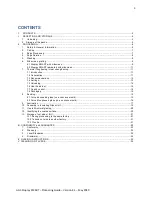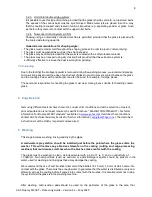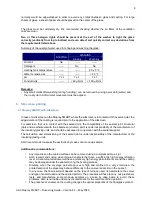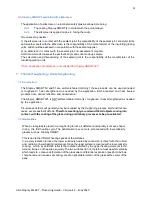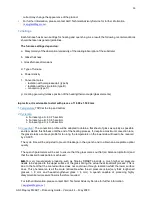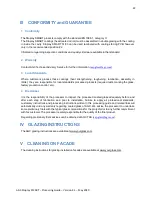
8
AGC Stopray SMART
–
Processing Guide
–
Version 4.1
–
May 2020
3.2.3.
Horizontal double edging system
It is possible to use this type of machine provided that the glass is held by smooth, non-textured belts.
The speeds of the various belts must be synchronised. Mains water jets are placed in such a way
that the coating is soaked and cleared of various impurities (e.g. separating powder or glass dust)
just before they come into contact with the upper roller belts.
3.2.4.
Numerical Control Systems (CNC)
Shaping using a numerically controlled machine is permitted provided that the glass is placed with
the coated side facing upwards.
General recommendations for shaping edges:
The glass must remain moist throughout the shaping process in order to prevent 'natural drying'.
The glass must be washed as soon as it has been shaped.
The glass may be drilled provided that the press is covered with a soft protective material.
The glass may be processed using dry crossed belts provided that the extraction system is
sufficiently effective to remove the dust resulting from grinding.
3.3
Unloading
Due to the fact that the interlayer powder is removed during the washing process, we recommend placing
micro-suction pads around the edge of each sheet of glass in order to prevent contact between the glass
and the coatings. Paper with a neutral pH can also be sued, for example, for large pieces.
The personnel responsible for handling the glass must wear clean gloves suitable for handling coated
glass.
4
Edge Deletion
Tests using different sealants have shown that, under strict conditions and with a selection of sealant,
prior edge-deletion is no longer required. A specific brochure “ SEALANT COMPATABILITY – Technical
information for Stopray SMART products” available on
describes these conditions.
Contact AGC Technical Advisory Service for further information (
). The described
instructions must be strictly respected and executed.
5
Washing
This stage involves washing, rinsing and drying the glass.
A main-water spray station should be installed just before the point where the glass enters the
washer. This will remove any abrasive elements on the coating (cutting and edge-processing
residues) that could cause scratches when the brushes make contact with the coating.
The glass must be washed in clean, deionized water with a pH of 7 (± 1) and a conductivity of
< 30µS/cm. No hard particles (such as calcium) or acidic/detergent agents should be present in the
water used for washing and rinsing as these may damage the coating.
We recommend the use of 'soft' brushes (diameter of the bristles <0.15 mm), 1-2 mm of which come into
contact with the glass. There must be enough water to guarantee that the water is distributed evenly and
efficiently across the coating before it comes into contact with the brushes. It is also important not to stop
the cycle whilst the glass is in the washing machine.
After washing, micro-suction pads
should be used on the perimeter of the glass in the area that



